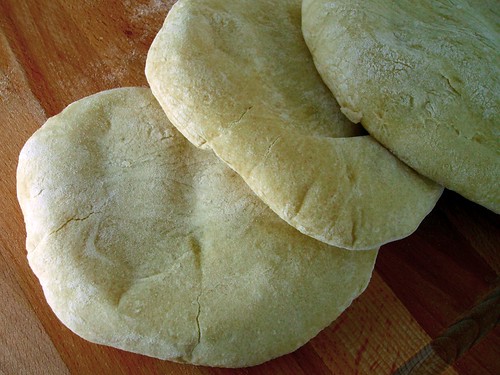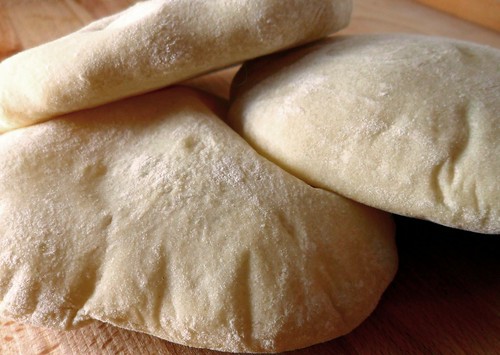These guys don't look like much when you put them in the oven, but it only takes seconds for them to start puffing up! That's probably why I like baking bread so much. It's so satisfying & exciting to see your doughy creation move and grow and multiply all on its own!!! (Well, with some help from yeast, warmth, and a little lovin')
Yea.....so that sounded a little creepy, eh?
...
These were made in order to have completely homemade gyro's (FABULOUS!), which I'll show you in the next few days.

Printable Recipe
by Brown Eyed Baker
Makes 8 Pitas
- 3 cups flour
- 1 1/2 teaspoons salt
- 1 tbsp sugar or honey
- 1 packet instant yeast
- 1 1/4 to 1 1/2 cups water, roughly at room temperature
- 2 tbsp olive oil, vegetable oil, butter, or shortening
Mix the yeast in with the flour, salt, and sugar. Add the olive oil and 1 1/4 cup water and stir together with a wooden spoon. All of the ingredients should form a ball. If some of the flour will not stick to the ball, add more water.
Once all of the ingredients form a ball, place the ball on a work surface, such as a cutting board, and knead the dough for approximately 10 minutes. If you are using an electric mixer, mix it at low speed for 10 minutes.
When you are done kneading the dough, place it in a bowl that has been lightly coated with oil. Form a ball out of the dough and place it into the bowl, rolling the ball of dough around in the bowl so that it has a light coat of oil on all sides. Cover the bowl with plastic wrap or a damp kitchen towel and set aside to rise until it has doubled in size, approximately 90 minutes.
When it has doubled in size, punch the dough down to release some of the trapped gases and divide it into 8 pieces. Roll each piece into a ball, cover the balls with a damp kitchen towel, and let them rest for 20 minutes. This step allows the dough to relax so that it’ll be easier to shape.
While the dough is resting, preheat the oven to 450 degrees. If you have a baking stone, put it in the oven to preheat as well. If you do not have a baking stone, turn a cookie sheet upside down and place it on the middle rack of the oven while you are preheating the oven. This will be the surface on which you bake your pitas.
After the dough has relaxed for 20 minutes, spread a light coating of flour on a work surface and place one of the balls of dough there. Sprinkle a little bit of flour on top of the dough and use a rolling pin or your hands to stretch and flatten the dough. You should be able to roll it out to between 1/8 and 1/4 inch thick – 6 inches in diameter. If the dough does not stretch sufficiently you can cover it with the damp towel and let it rest 5 to 10 minutes before trying again.
Place discs on a lightly greased baking sheet (or parchment paper) and let rise, uncovered, until barely doubled in thickness, about 30-45 minutes.
Open the oven and place as many pitas as you can fit on the hot baking surface. They should be baked through and puffy after 3 minutes. If you want your pitas to be crispy and brown you can bake them for an additional 3 to 5 minutes, but it isn’t necessary.


No comments :
Post a Comment